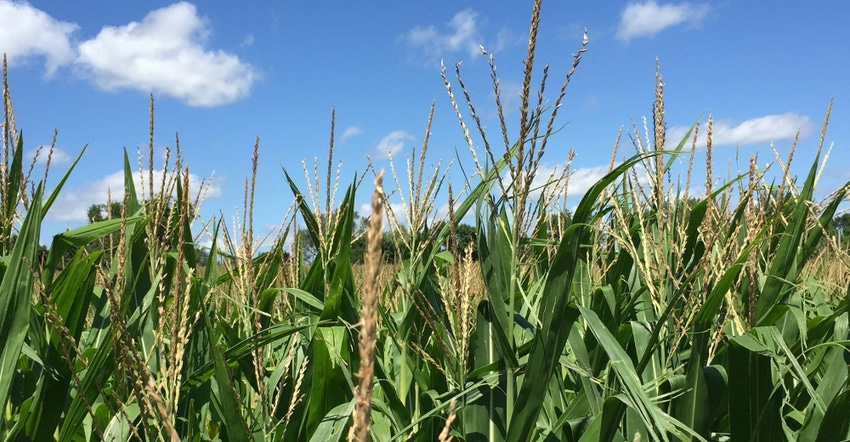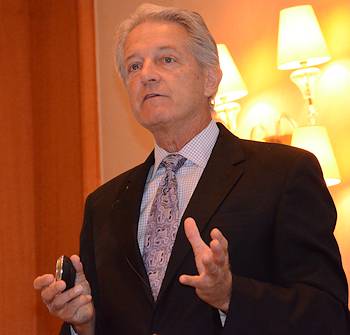October 28, 2016

Earlier this year, EPA issued a draft notice as the kick-off to the ecological evaluation, required by law, for atrazine. Farm groups and others, including atrazine's originator Syngenta, noted a wide range of issues with the draft document the agency issued. It was an error-filled document that got plenty of attention. This week, a retired toxicologist with a long history of working with the herbicide, issued a simple message: keep calm, atrazine will be re-registered.
And Tim Pastoor should know. The long-time Syngenta toxicologist has been through plenty of reregistration processes in the past for the herbicide. During the Syngenta Media Summit this week, he offered a little background on the topic. "Atrazine is a great product, not just for Syngenta, it's great for the farmer," he notes. "There's an enormous amount of information and research that has been done on the product."
In fact, atrazine has been on the market for more than 50 years, and Pastoor says that there is more data on the product than "virtually any molecule on the planet." It is one of the best studied molecules on the planet.
The EPA is doing its duty, which by law requires a reregistration of crop protection products every 15 years. The last reregistration was 2003 so this 2016 process is aimed at completing reregistration by the 2018 timeframe. To be successful, Pastoor says there are three things that are critically important to the maintenance and registration of the product.
First, the product has to have value to the market, which has been demonstrated for the farmer, for Syngenta and for a farmer's ability to produce food.
Second, the registration process, which is ongoing really, has been supported by key people at Syngenta Pastoor called out including Janice McFarland and Dan Campbel, without whose work the product may not be on the market.
And finally, the science is "incredibly important." "We have to make statements with confidence before the media, the scientific advisory panel [for the EPA]...and we have to state facts that support what we're saying. We're not waving our arms about, and making conclusions [without facts]."
When talking about the value of the product, Pastoor calls atrazine the "aspirin of agriculture" and he says that because in effect it's inexpensive "and it works." He points to numbers that show on average atrazine can save a farmer more than $30 per acre in a given season. "That's why the farmer sees a tremendous value."
Going through the process

Tim Pastoor, toxicologist, Syngenta, has a long history of working with the herbicide registration process and he has confidence in the system, and science behind the long-used herbicide.
Pastoor, who has been attacked by anti-atrazine groups in the past, has a long history of managing research and gathering information from others who have researched the crop protection product. When the product goes to EPA for reregistration, there's a mountain of evidence that goes along too.
"For most active ingredients you might have 100 or 200 studies. We have more than 7,000 for atrazine," Pastoor notes. From Australia, the World Health Organization, and even the United Kingdom have approved use of the product. Note: Atrazine is not registered in Europe, due to a zero-residue standard that no herbicide can meet. The UK approval of the tech, does not mean farmers there can use it, but does mean that those "EU bans" you always hear about are more complicated than you might think.
This latest reregistration process is focused on atrazine in the environment – the ecological effects. Syngenta is pulling together research now, from that vast library, to support continued use of the herbicide for the farm. The hubbub over the initial EPA report, he says, will be taken care of as part of the process.
The flawed initial EPA report comes from an issue that Pastoor explains simply and involves the concepts of complex versus complicated. "The database for atrazine is complex, but it is not complicated," he says. "There are high-quality studies of atrazine in that database to base decisions on, and good data to make good registration decisions, it's not complicated."
He explains that EPA looked at the huge universe of data – and 7,000-plus studies is a huge universe – and didn't get it right the first time. "But they will. In 2017 there will be scientific advisory panel meetings, and they will advise the agency on the studies and revise the draft ecological assessment," Pastoor explains.
He notes that in the initial draft there were things that just weren't correct where milligrams were confused for micrograms, and selecting a flawed study to work with rather than a more rigorous study looking at the exact same issue. This will be sorted out as part of the process, and the large number of comments filed with EPA (the comment period closed on October 4) will help.
Farm groups informed about the initial ecological assessment got the word out, and farmers did chime in with their support of the product, which Pastoor says EPA does listen to as part of the process.
His conclusion: "This is a transparent process and we expect to get these things right...we anticipate that atrazine will go through the review and be available farmers for the future."
The reregistration process is cumbersome, but it works, and Pastoor has seen enough of that to know.
About the Author(s)
You May Also Like






